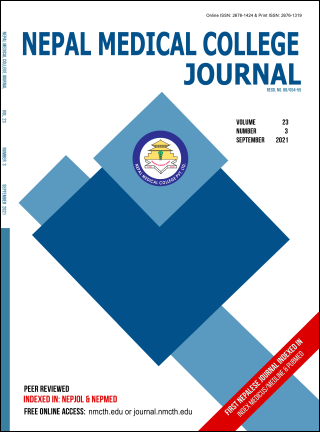Cardiovascular Risk Assessment in Hemodialysis Patients
DOI:
https://doi.org/10.3126/nmcj.v23i3.40385Keywords:
Hemodialysis, Homocysteine, high sensitive C-reactive protein, oxidized LDL antibody, Red cell distribution widthAbstract
Cardiovascular diseases are the leading cause of death in hemodialysis patients. We aimed to evaluate non-traditional cardiovascular risk factors: homocysteine, high sensitive C-reactive protein, oxidized LDL antibodies, phosphate, and red cell distribution width in chronic kidney disease patients under maintenance hemodialysis along with traditional cardiovascular risk factors like age, hypertension, diabetes mellitus, among others. A total of 78 diagnosed chronic kidney disease patients under maintenance hemodialysis visiting a tertiary care center were included in the study, of which 59% were male. Hyperhomocysteinemia was present in 79.5% of the participants, with the median homocysteine level being 28.43 μmol/L. The median hsCRP level was 4.74 mg/L, and 59% and 24.4% of the total participants were at high and moderate cardiovascular risk respectively. The median oxidized LDL antibody level was 4235 U/mL, which is within the reference range. The median red cell distribution width was 14.05%, which is within the normal range. Left ventricular hypertrophy, a common cardiovascular disease in such patients, was found in 55.13% of the participants. Serum homocysteine level was significantly higher in patients with left ventricular hypertrophy, whereas serum C- reactive protein level was significantly lower in patients with left ventricular hypertrophy. The mean serum phosphate was 6.23 mg/dL (i.e. higher than normal) and hyperphosphatemia was seen among 76.9% of the patients. The mean age of the patients was 47.5 years, which is distinctly lower when compared to the hemodialysis patients in the Western population. The prevalence of hypertension, diabetes mellitus, and anemia were 95%, 18.25%, and 92.3%, respectively.
Downloads
Downloads
Published
How to Cite
Issue
Section
License
Copyright (c) 2021 Nepal Medical College Journal

This work is licensed under a Creative Commons Attribution 4.0 International License.
This license enables reusers to distribute, remix, adapt, and build upon the material in any medium or format, so long as attribution is given to the creator. The license allows for commercial use.




